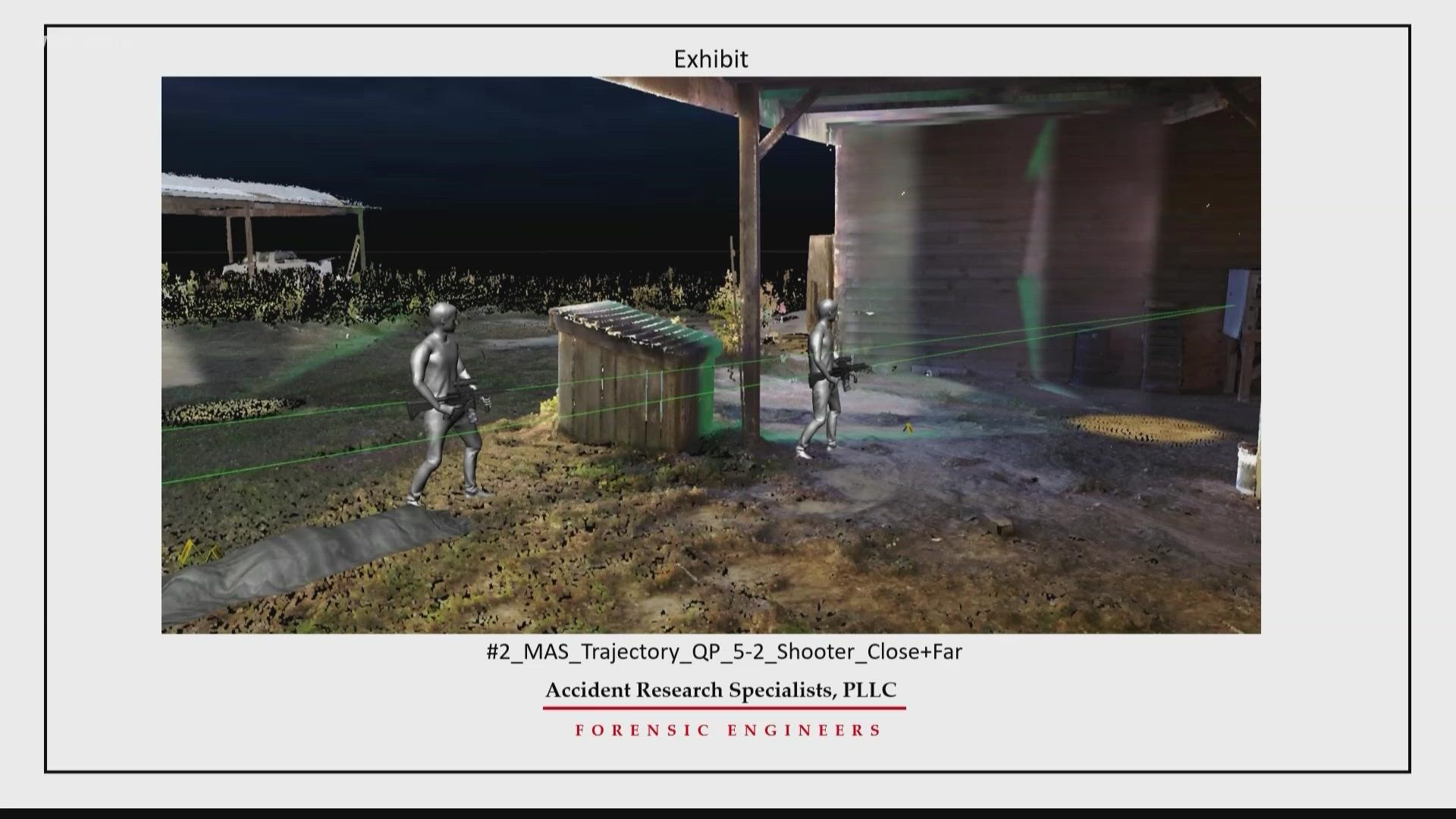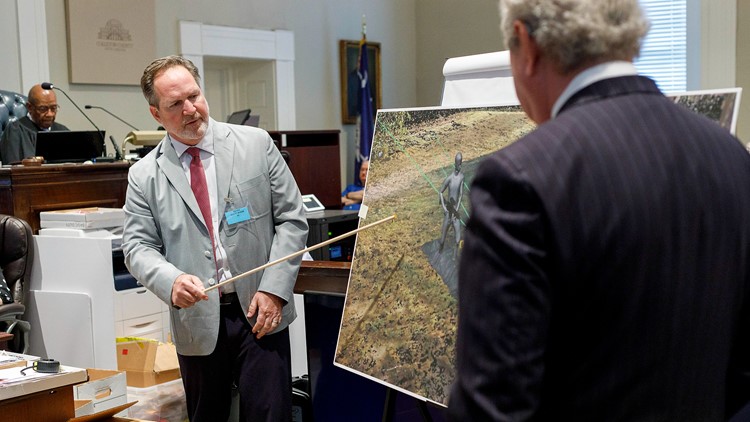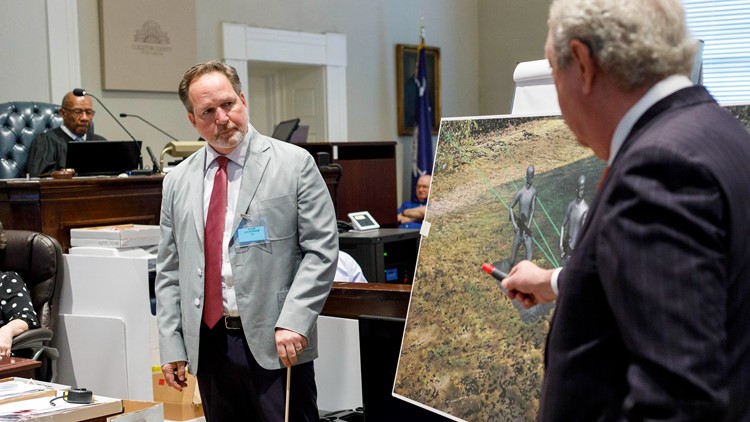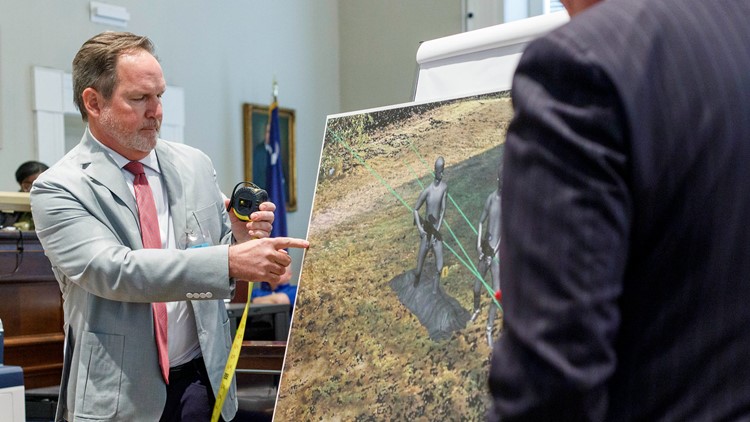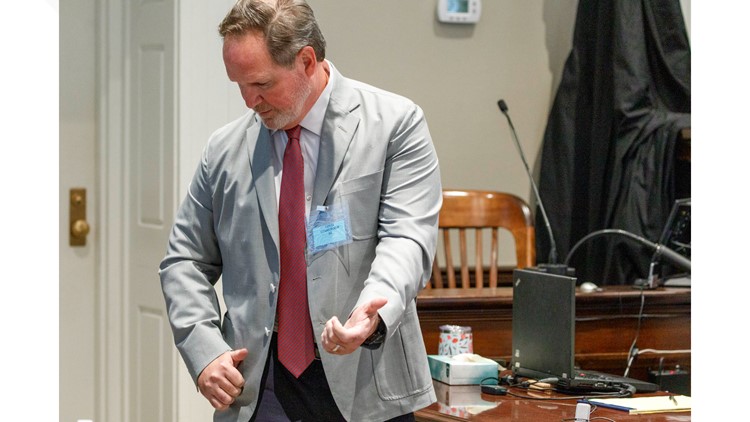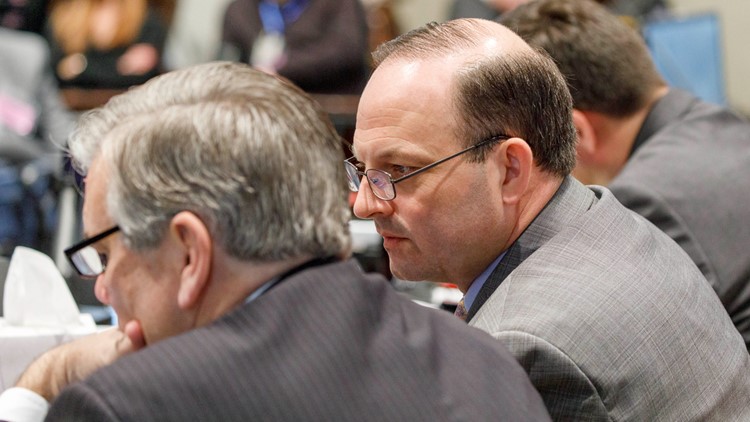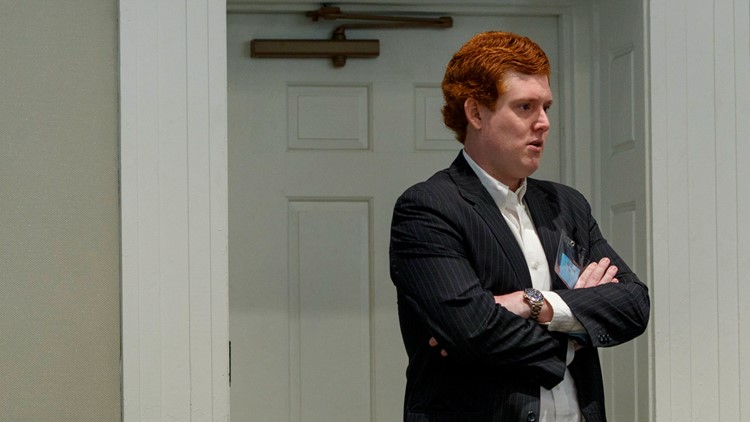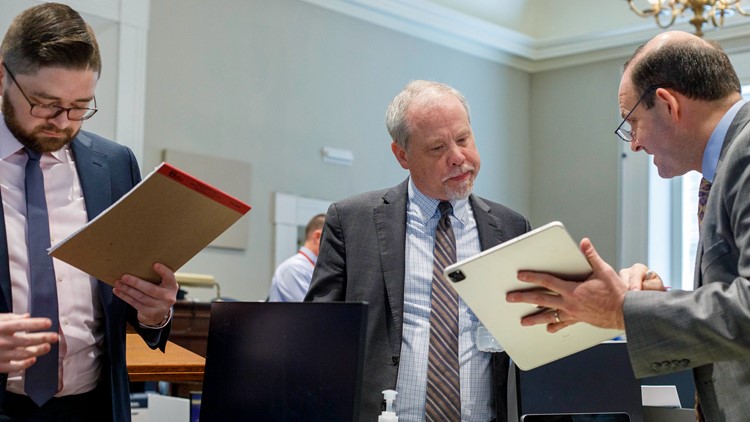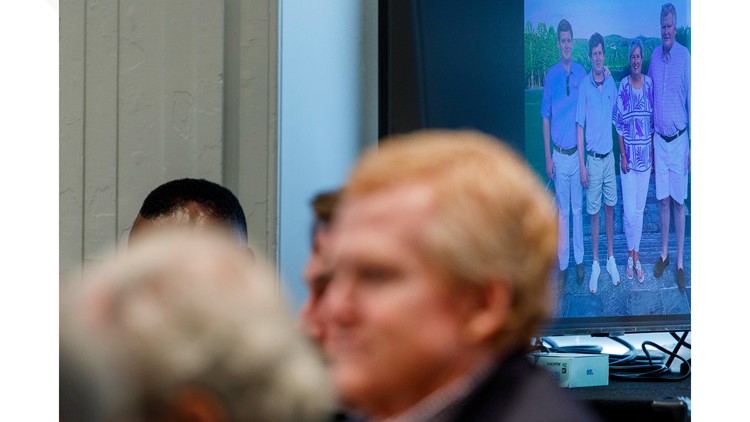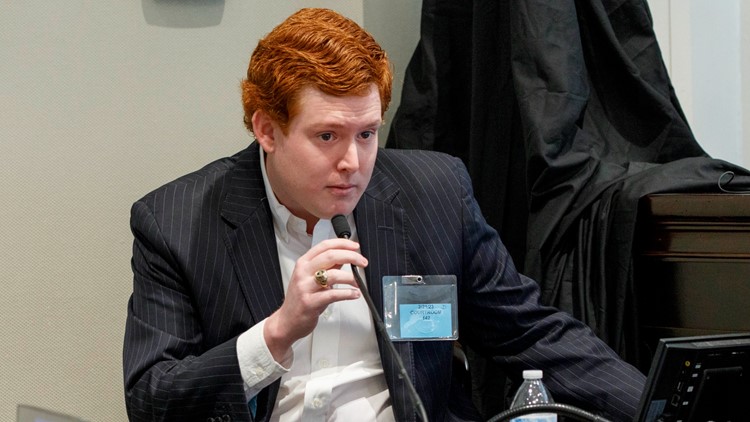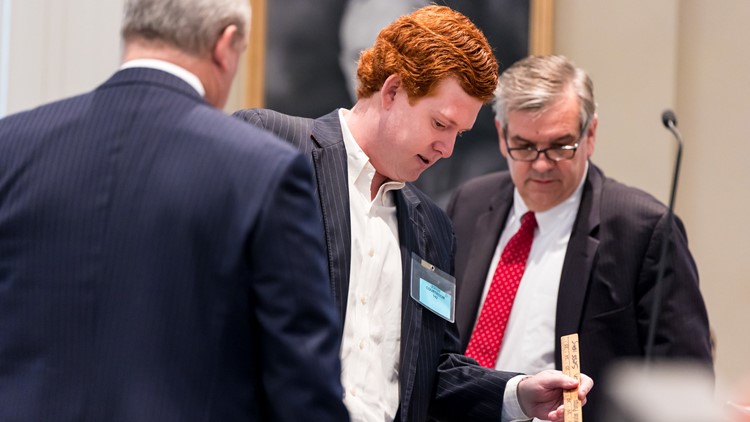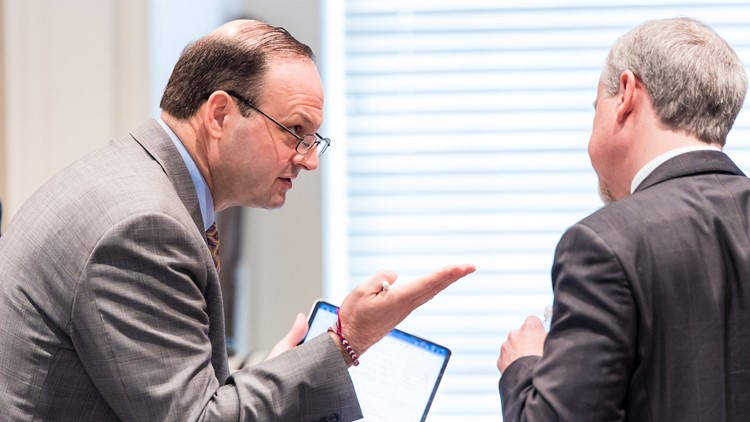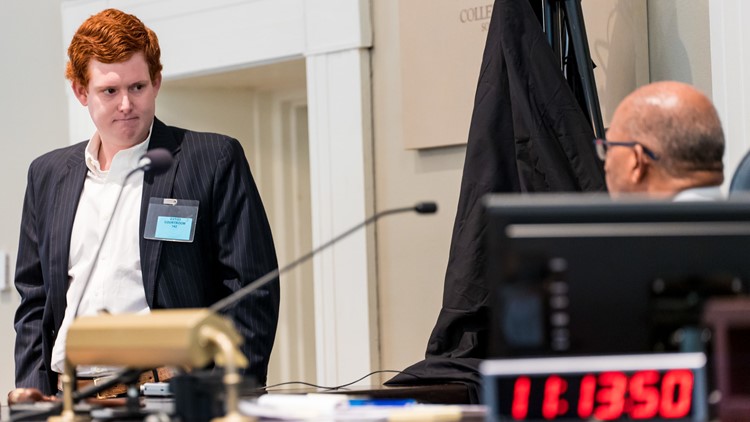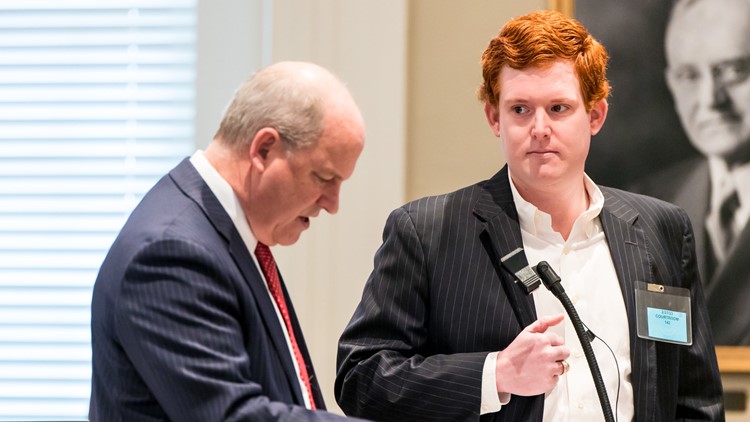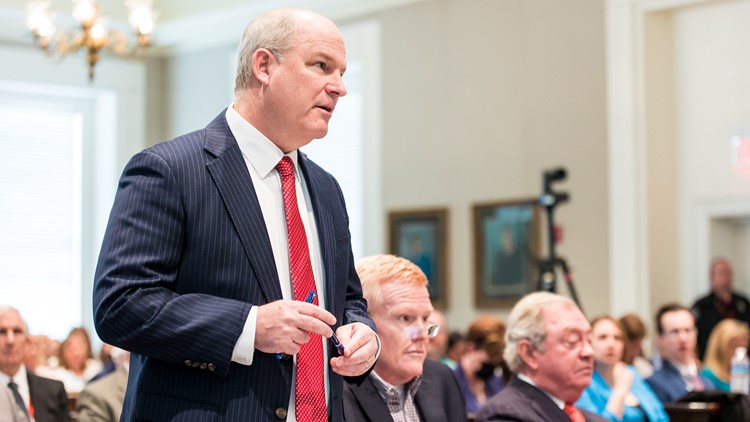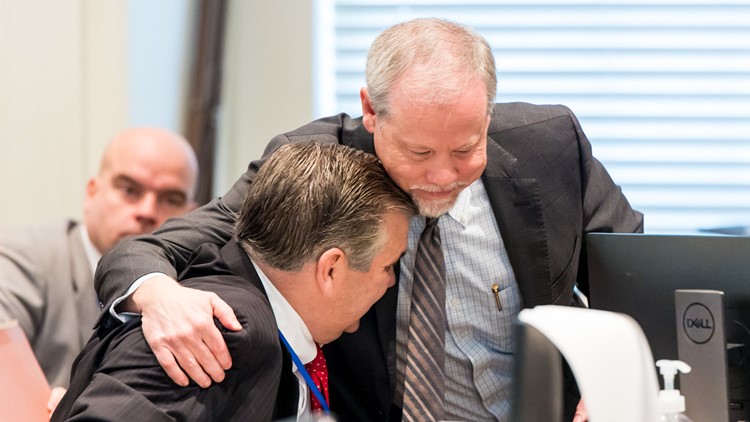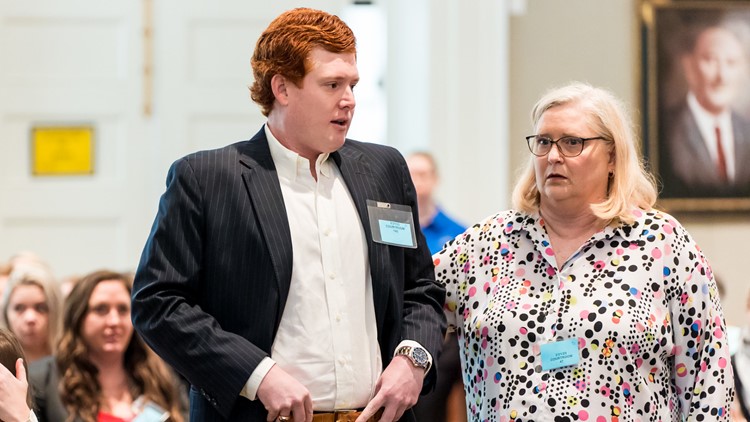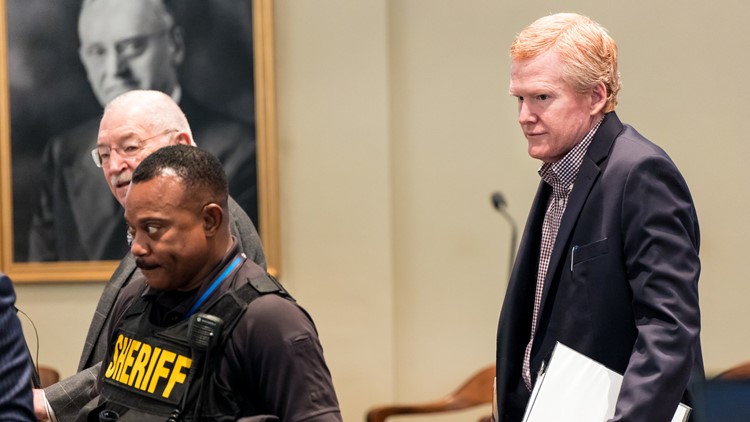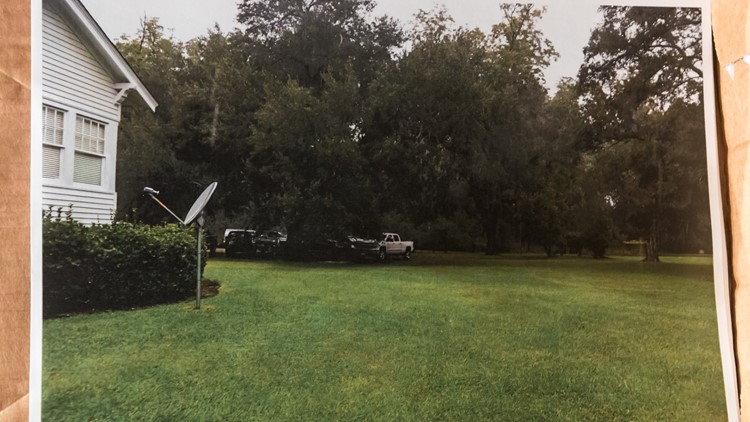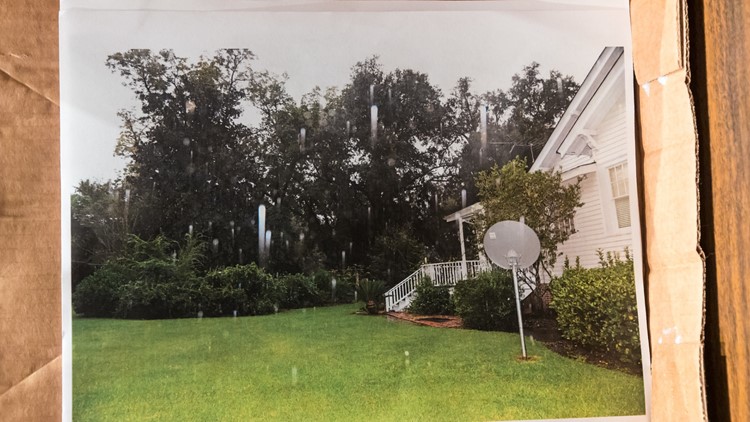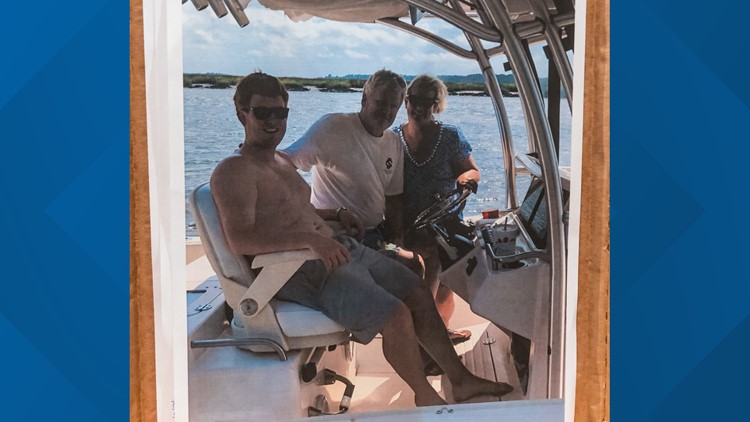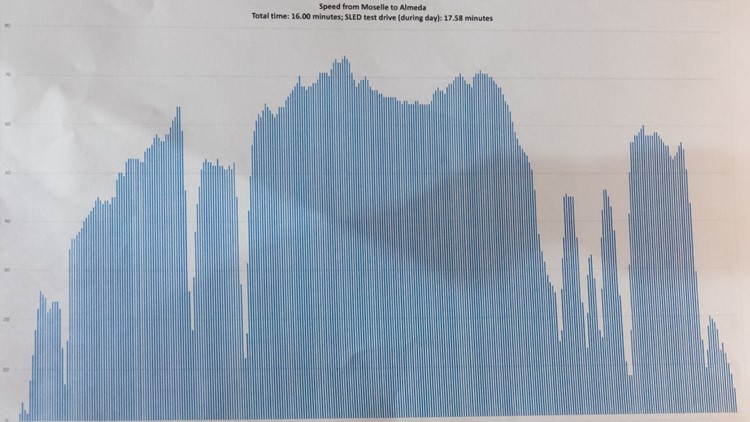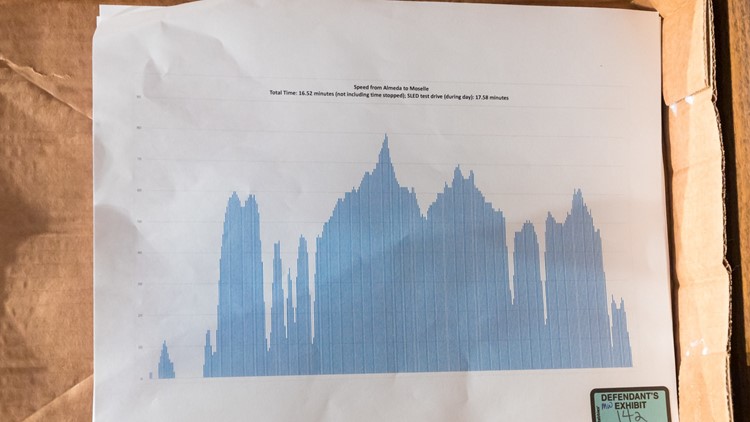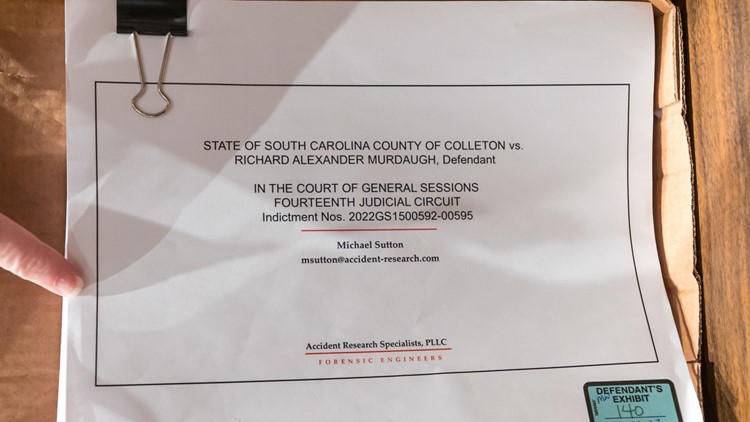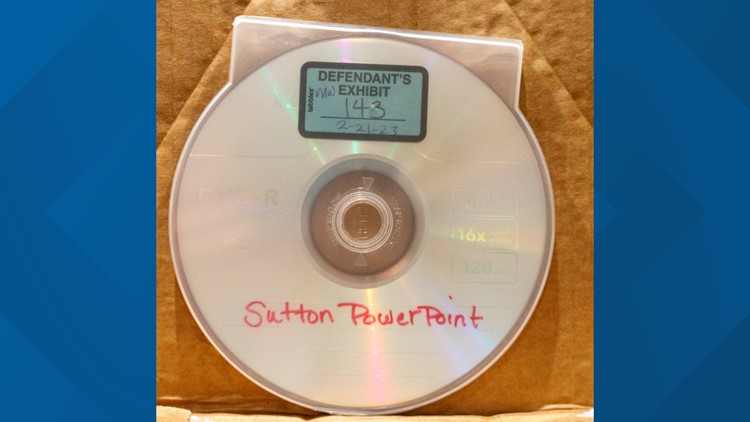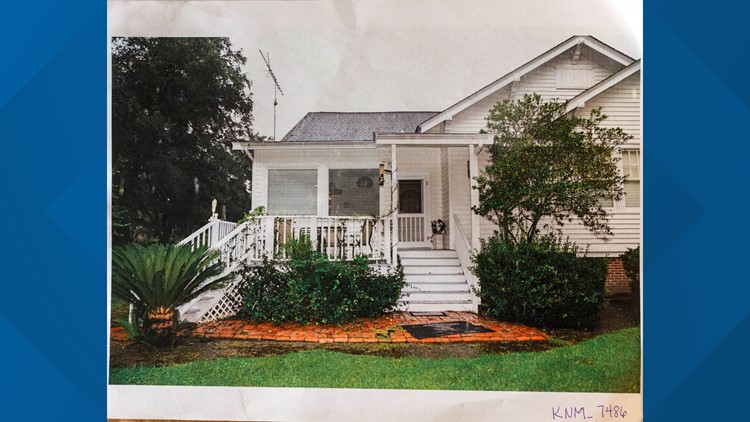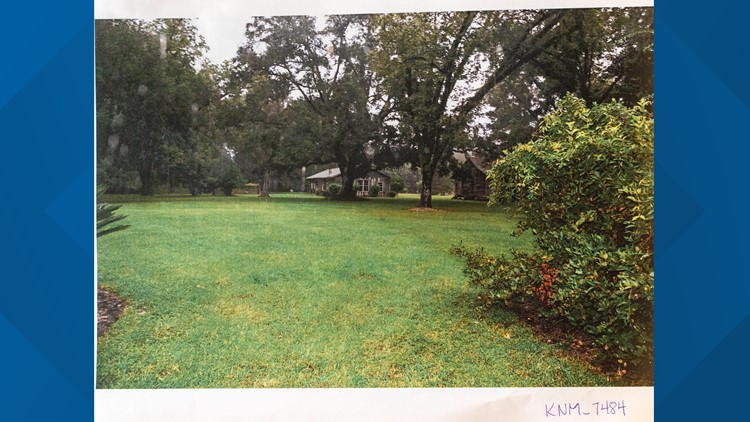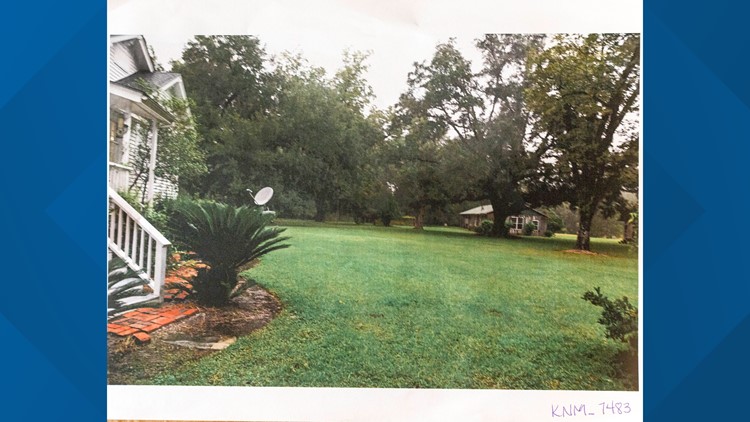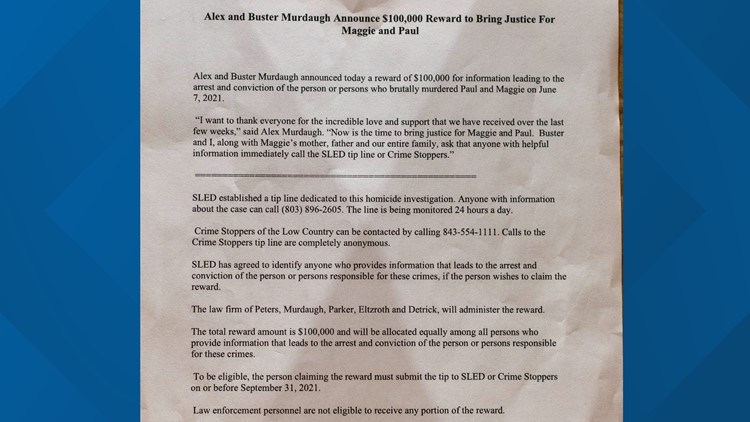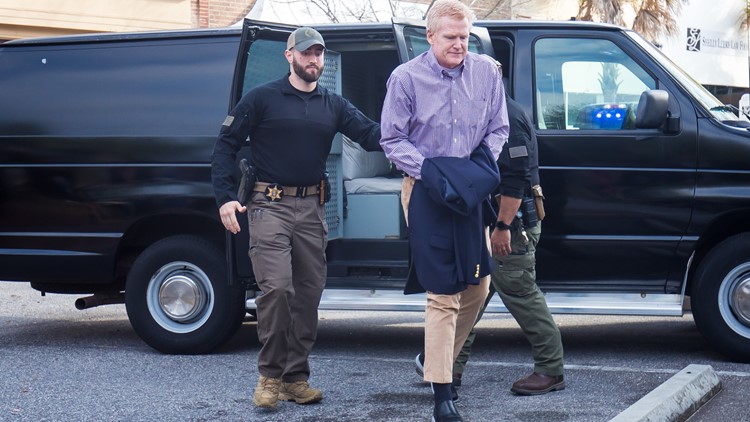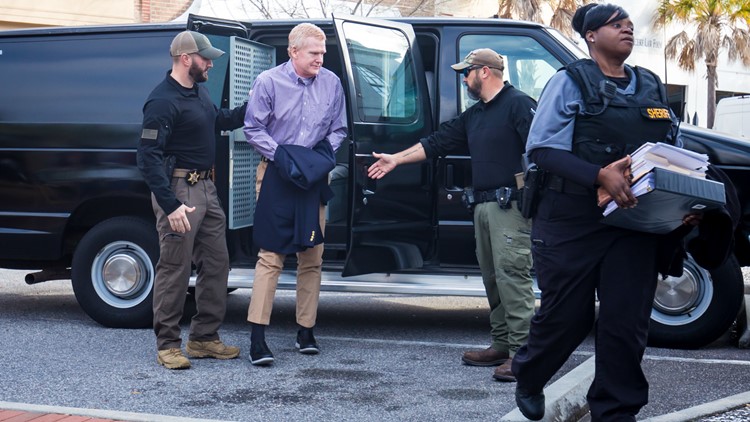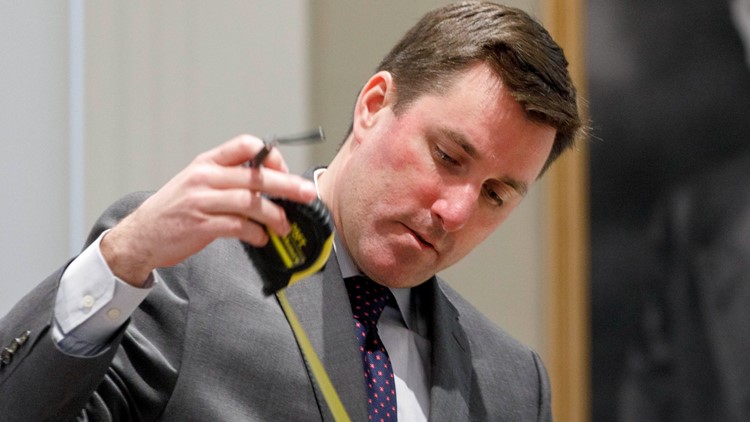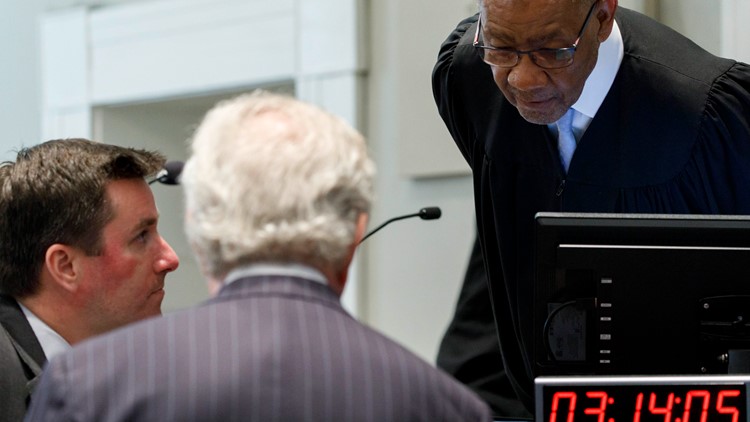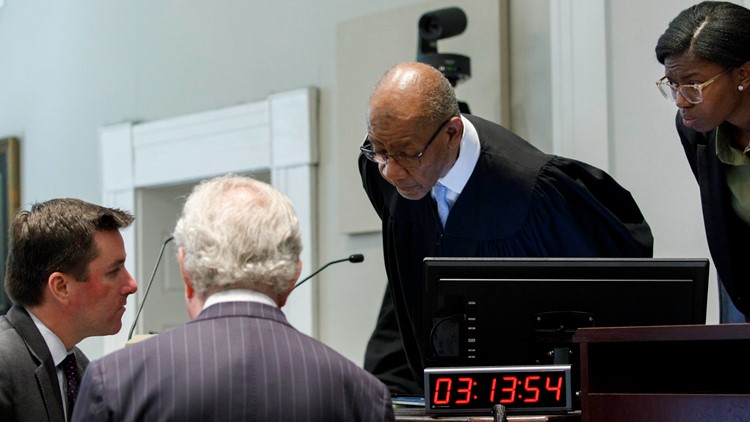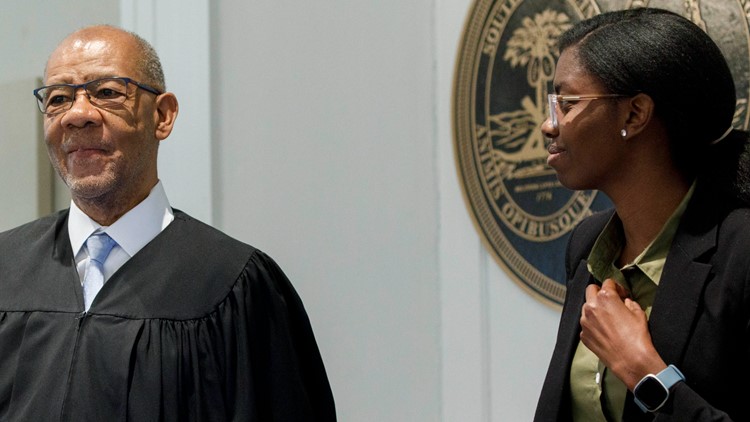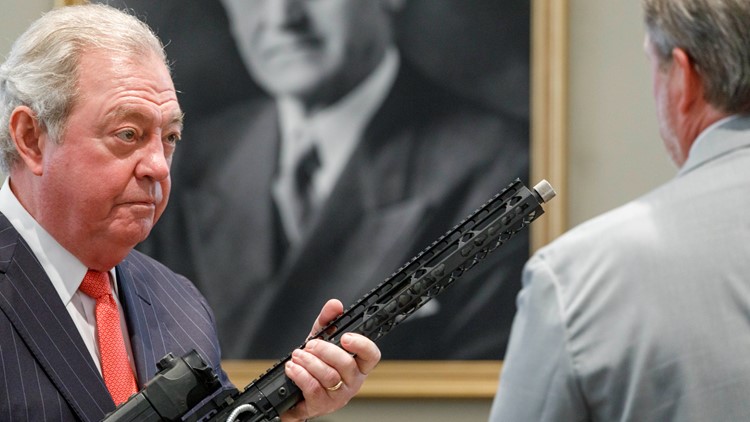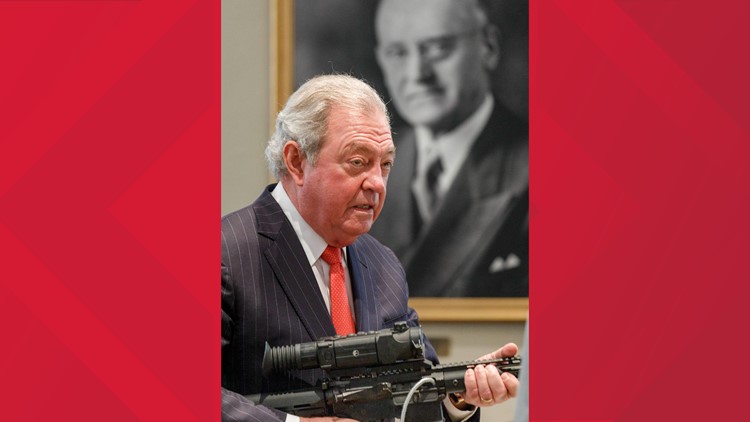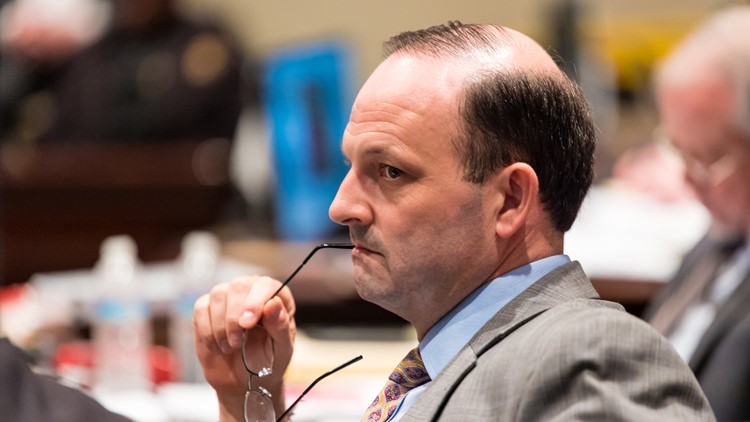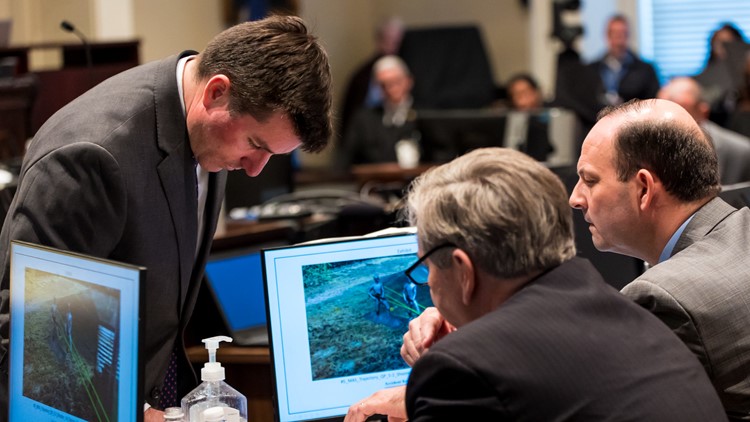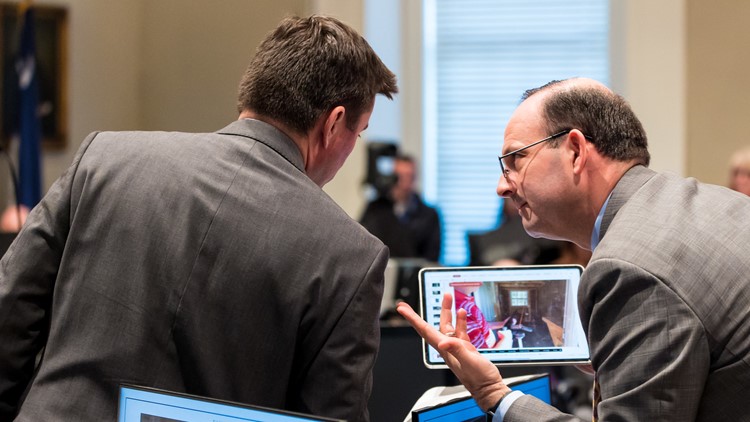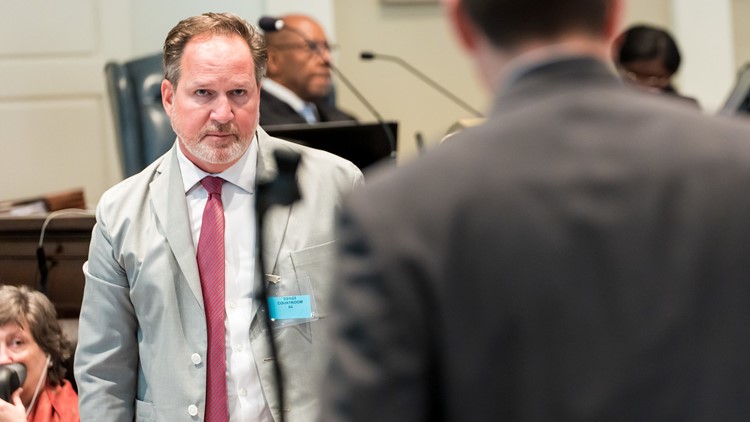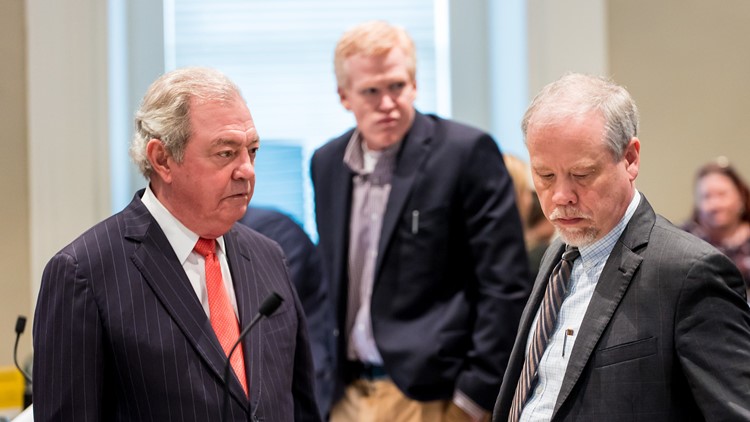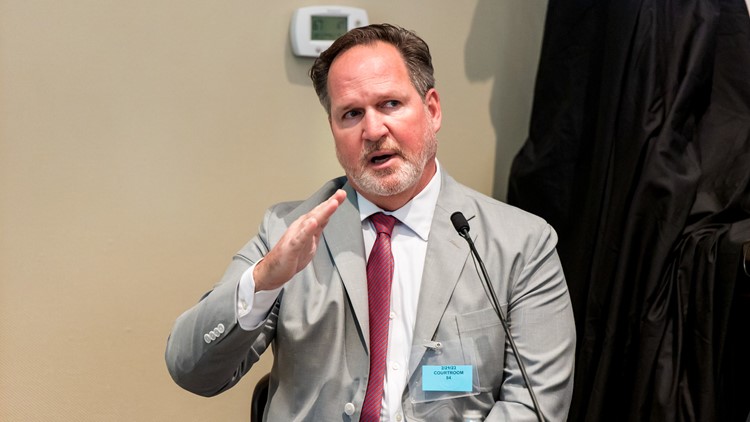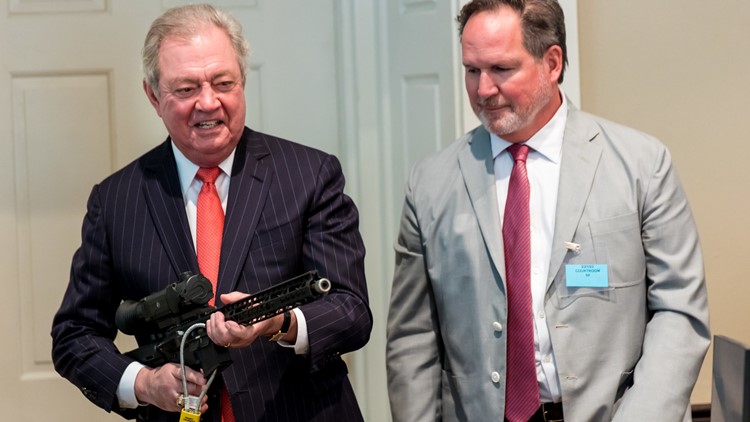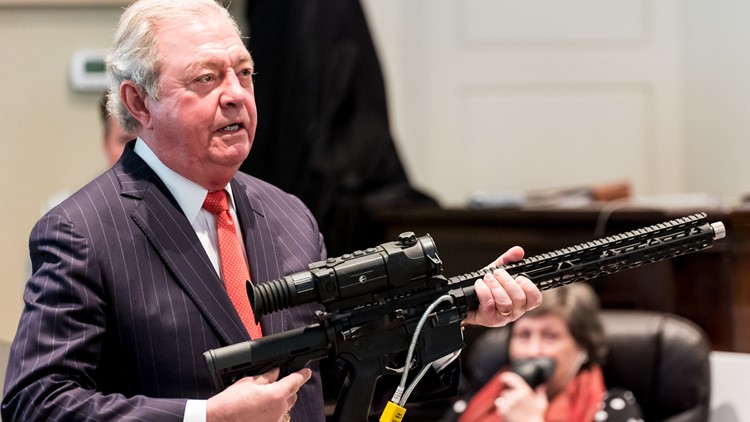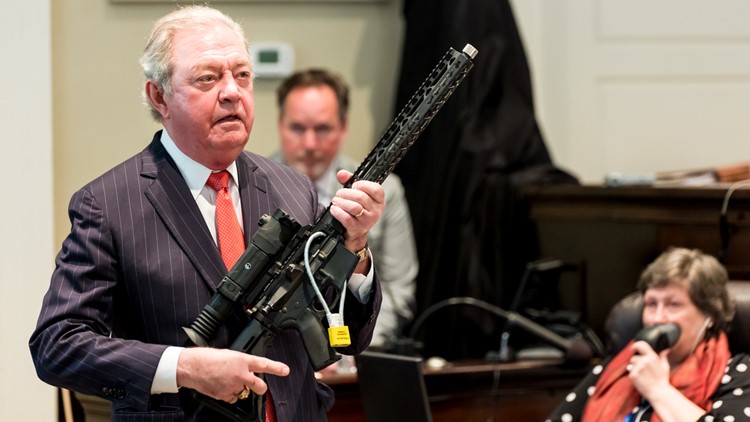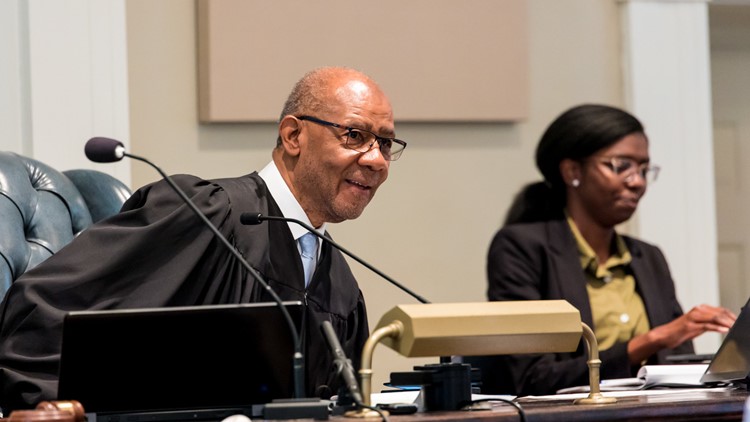WALTERBORO, S.C. — Jurors in the Alex Murdaugh trial heard from Alex Murdaugh's surviving son and a forensic expert who said the defendant couldn't possibly have fired the fatal shots that killed his wife and son almost two years ago.
After a long break for the President's Day Holiday weekend, the court resumed where it left off Friday, with defense witnesses.
Murdaugh is accused of shooting to death his wife Maggie and adult son Paul at their 1,700 acre property known as Moselle in June of 2021. He's also facing separate trials for massive financial fraud accusing him of taking millions from his law firm and clients. Murdaugh's lawyers maintain he's innocent and there's been a rush to judgment, while prosecutors say he acted alone in killing his family.
It's unclear how many witnesses the defense intends to call or whether Murdaugh himself will take the stand.
You can find trial updates here every day. Live streaming coverage can be on wltx.com, on the WLTX+ streaming app on Amazon Fire and Roku TV, and on the News19 WLTX YouTube page.
Alex Murdaugh trial Tuesday updates
Before the defense team begins the second day of testimony for Alex Murdaugh, another juror was replaced due to the illness and Judge Newman took defense attorney Jim Griffin to task for retweeting an article regarding the case that criticized one of the State’s witnesses.
The first witness called Tuesday for the defense was Richard Allen “Buster” Murdaugh Jr, the eldest son of Alex and Maggie.
Buster tells the court he grew up in Hampton County, went to public schools and enjoyed hunting and fishing. Said Alex coached him and Paul while on sports teams, it was rare for his parents to miss their games.
He said the family had a house in Hampton when they purchased Moselle. They stayed in Hampton until hurricane damage caused damage to the house and the family moved to Moselle. They spent time at the beach house at Edisto as well.
Buster talks about the Moselle property – roughly 1,700 acres, most of that inaccessible, broken up to parcels with deer stands, dove fields and duck ponds. Friends and family would hunt the property. The house near the road on Moselle is a cabin where Buster and two friends (Nolan Tuten and Rogan Gibson) lived.
Buster said they had a lot of guns: 12-, 20-, 16-gauge shotguns; rifles, 300 Blackout and all of the ammunition to fit. Guns kept in gun rooms with pool table. Guns were left at shed, on golf carts, trucks, etc. Paul was not good at securing guns and carried guns in his truck.

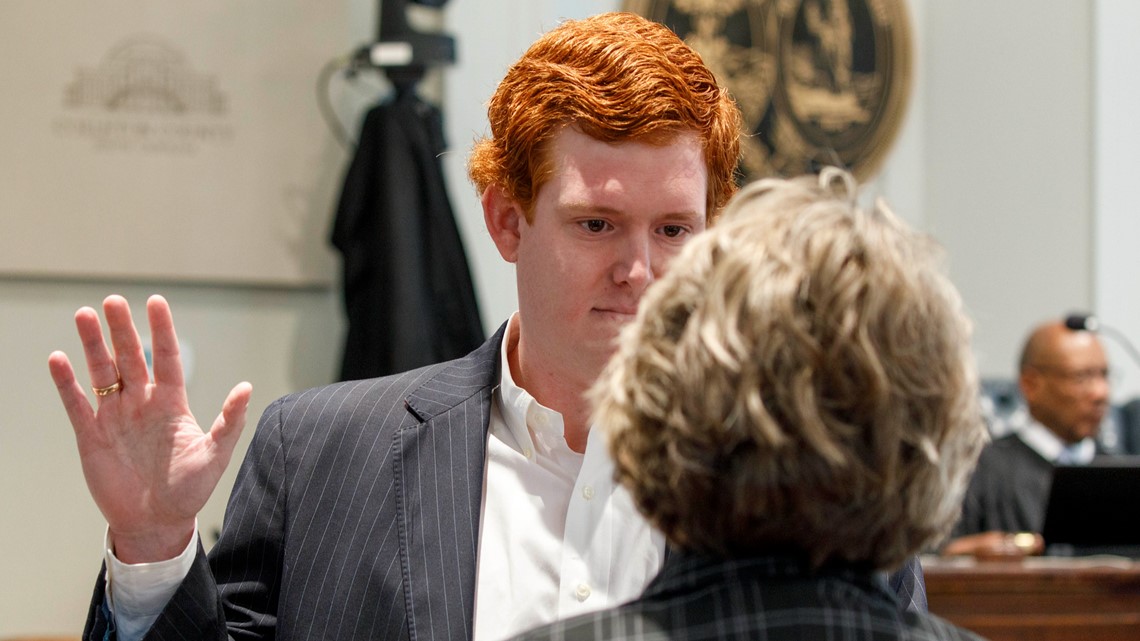
Buster and Paul got 300s for Christmas. Buster’s 300 was black and is the one entered into evidence. Paul’s 300 was black and tan. Buster said Paul’s gun was stolen or taken and Buster’s was used by Paul. Buster unaware Paul got a replacement because he used Buster’s.
The Benelli 12-gauge shotgun entered into evidence is also Buster’s, he testifies. The Benelli was loaded when it was put into evidence with a 3 and a 3 ½ turkey load. Buster said that is what he does normally. He testifies he does not load a buckshot followed by a birdshot and doesn’t recall anyone at Moselle doing that.
Buster said there are two entrances at Moselle, one straight out of the main house with brick gates, the second is near the kennels with the mailbox. Buster testifies Maggie took the main entrance unless there was a delivery expected and she would go to shed entrance. Leaving the house, family used main gate.
Almeda is a right turn out of the main gate.
Maggie preferred to stay at Edisto in the summer. Buster stayed at an apartment in Columbia and Rock Hill and visited Moselle in the spring 2021; Paul was in Columbia in spring 2021 and lived/worked with John Marvin in Hampton.
Buster said the Murdaughs and Maggie’s parents/family, the Branstetters, would vacation together, hold family events. Alex was close to Maggie’s father.
Buster said Almeda is about 10 minutes from PMPED and from the Hampton house, about 20 minutes from Moselle.
John Marvin, Randy and Lynn are Alex’s siblings and would congregate at a family river house.
In May/June 2021, Randolph had cancer, Libby had Alzheimer’s. Alex would check on his parents almost every day, no set schedule. Maggie and Paul went – Paul went regularly. Buster said he might go to Almeda in the afternoon with Alex and park in the garage, sometimes pull through to the back to go in the back door.
Buster is asked to look at the GM GPS map of the Almeda property. The dots on the map are off the back corner of the house, where they would usually park in the back of the house.
Griffin shows Buster other images of the house and asked to identify them. Buster says they are photos of the area near the back of the house. One photo shows the kitchen/sunroom entrance to the house, another photo of same area at another angle. The grandparent’s bedroom is on the back right of the house. Buster said if you parked at the front of the house, you’d have to call the house and tell them you were there to get the front door unlocked. It was easier to go to the back.
Buster points out the area in the grass where he would park, at the base of the steps. There is also a cook’s shed and another old shed on the property, about 10-20 yards from the house, Buster said.
Buster said he talked to Alex and Maggie almost every day on the phone.
Griffin pulls up Rudofski’s report, starting at 1:11:10 p.m. where there are logs between Paul, Maggie, Alex, and Buster. Buster said that is a normal communication day, nothing unusual in the number of calls or times.
A call around 9 p.m. from Alex to Buster, Buster said was Alex was calling to say he was visiting Almeda. Buster said Alex sounded normal, it was common for his father to call him when he was going to visit Libby Murdaugh.
Cell phone service was not great, Buster said, spotty around property. Metal roofs on structures made service worse.
Alex wouldn’t necessarily have his phone on him; Paul would have his phone near him; both frequently misplaced their phones.
Bubba was a yellow lab owed by the family, Buster said Buster would listen to Alex.
Buster said Alex showered frequently when at Moselle, sweated a lot. Weighed more around June 2021.
Buster said he knew a little bit about Alex’s opioid problem, Maggie and Paul found pills, Alex went to detox around 2018 and thought it fixed the situation, but more pills found; Alex did some in-home detox and Buster thought Alex beat it. Buster wasn’t there when confrontations about pills were done, Alex would apologize.
Buster said family disputes were talked out, handled civilly, no violence in family.
In 2019, Paul was in boating accident and criminally charged. Buster said there was a negative reaction to the family in the media -- Paul became bullied on social media with random messages, yelled at on the street.
Buster said Maggie was consumed by media coverage and ultimately caused her to distance herself from Hampton.
Buster was sued in the boat case as was Alex, and Maggie’s estate. Maggie was anxious about the civil suit, concerned about the money wanted from the family for the Beach family. Alex didn’t appear to be overly anxious about the civil case, more concerned with criminal case. Family supported Paul in criminal case because the Murdaugh family didn’t think Paul was driving the boat at the time of the crash.
Leading up to June 7, Buster was with family on Memorial Day weekend at Edisto.
Buster identified a photo of Buster, Maggie, and Alex on a boat that holiday weekend. There was a birthday cookout for Alex, Maggie made the cake.
The following weekend was baseball in Columbia and Buster, girlfriend, Maggie, and Alex went to the games Saturday and Sunday. Buster said it was a normal weekend.
June 7, there were a host of phone calls. Buster found out about the murders from Alex, he doesn’t recall the time. Girlfriend Brookland started packing things and Buster sat there for a minute in shock and drove to Moselle, arriving around 2:30 am. Buster said Alex looked destroyed, crying.
Buster said Brookland, Randy, John Marvin, Chris Wilson, Corey Fleming, several of the partners from PMPED, Nolan Gibson was there. Buster said he stayed until around 5 a.m. then he and Alex went to Almeda.
Alex was wearing shorts and a t-shirt. Buster said he grabbed, t-shirts from the closet and shorts for Alex to go to Almeda.
Buster went back to Moselle with Alex and Brookland next morning. John Marvin was there also.
Buster said he showered at Moselle, as did Alex. He said he doesn’t remember what Alex was wearing.
After returning to Moselle, Buster said he was with Alex every day for a good while.
June 8, Buster said he and Alex were either at Almeda or John Marvin’s hunting lodge. June 9, Buster said he was at John Marvin’s place at Greenfield, just down the road from Almeda. Buster said he stayed several days at Greenfield, probably through the weekend. Buster said he was physically close to Alex all of the time. Funeral services for Paul and Maggie were on Saturday, for Randolph on Sunday.
Buster went to Summerville the next week.
Buster is asked to identify a document showing when he went to Summerville, a text thread between Buster and his girlfriend. Buster stayed in Summerville June 14 until June 17, then went to Lake Keowee on June 17. After Lake Keowee, Buster went to Rock Hill at some point. Buster had a job in Charlotte.
Buster said he talked to Alex about his safety. Buster said he didn’t take any security protection, didn’t want to carry a gun or have a security detail. He was staying hotels or girlfriend’s house that had security.
Alex and he announced a reward for information about the murders -- $100,000 “to bring justice to Maggie and Paul.” There was an expiration date of September 1, Buster not sure why.
In early September 2021, Buster said Alex went to detox and the roadside shooting. Buster said he never came home after detox. Buster said Alex had clothes at Almeda, Moselle, Greenview, in his car and other places.
Buster said, to his knowledge, Alex never spent another night at Moselle.
PHOTOS: Alex Murdaugh murder trial - Day 21 (Tues, Feb. 21)
Buster is shown the snapchat video of Alex and the bent over tree. Buster recognizes the shirt as a blue button-down shirt, not a Columbia shirt. Buster said he never saw his father in Vineyard Vines clothing, didn’t know if he ordered any.
Buster played in golf tournament in Summerville and Alex came to watch the last weekend in August 2021.
Alex kept items at Johnny Parker’s house near John Marvin and would stay there. Buster said he wasn’t present when Alex talked to Bianca.
Buster said he and Alex played golf later that month.
Buster has been in the courtroom and witnessed the June 10 video where Alex allegedly said, “I did him so bad.” Buster said Alex is saying, “they did them so bad.” Buster said Alex said that more than one time and said it at Moselle.
Buster said he didn’t know anything about Alex stealing money
It takes roughly 10 minutes to clean dog kennels, Buster said.
CROSS EXAMINATION by John Meadors
Meadors asks Buster about leaving the Moselle – did he use the mailbox at the side or kennel entrance -- and if packages would come to the shed/kennel side. Buster said the family would use main but certainly could leave either way.
Meadors asks, leaving the main and looking to the left, you might see lights at the kennels? Yes, sir, maybe.
At Almeda, is that close to the law firm? It’s a 10- to 12-minute drive from the law firm.
Buster points out where people might park at Almeda – near the back steps on the grass at the back corner of the house. There is a paved driveway at the side of the house.
Meadors asks Buster when he first discussed parking at Almeda? A couple of days ago.
First time you mentioned that? Sure
After Shelly Smith testified? I don’t know when Shelly testified
Did you bring that to someone’s attention, or did someone talk to you about it? Don’t recall. Most of the time we would call when we got there, it was easier to call to tell them.
Ever been there (Almeda) around 6 in the morning? Yes, going hunting.
You called the folks in the house? Sure
Meadors asks Buster, your mom loved Edisto? She was getting work done in the house? Yes
It was her plan was to stay there at Edisto that night? I don’t know what her plan was.
You said the last time you were at Moselle was in the Spring? Yes
You talked to mom on June 7? Yes
The last time you talked to Paul was June 5? Yes
Mr Griffin asked you about financials, you didn’t know about Alex’s financial difficulties? No
You went to Wofford and thought all was well in the family’s financial situation? When did you learn it wasn’t? I guess September, whatever day in September it was.
In the Memorial Day weekend video, Chris Wilson was shown hugging your dad on his birthday, you didn’t know Alex had stolen $192K from Wilson? No
The boat accident was pressure on the family? Unsettling, maybe not pressure.
Your mom felt ostracized from Hampton and wanted to stay at Edisto? Yes
Paul used your ID sometimes? Yes.
Did that frustrate you? Sometimes
Meador asked Buster if he had been shown the tree video, did you see Alex and what did he have on? Shorts and t-shirt
Who laundered his clothes? At that time, it was Blanca.
Did Alex try to get you to go hunting at Moselle after the murders? Yes, but didn’t Buster said he want to go.
REDIRECT
If your mother… when she went to Edisto and stay a coupe of nights, would she take Bubba? She would take dogs with her.
And Bubba and Grady were at Moselle that night.
Mike Sutton
Sutton, a mechanical engineer by education, is a consulting forensic engineer. He investigates accidents and attempts to explain what happens during an event using science. Accident Research Specialists is his company. Has done shooting incident reconstruction using external and terminal ballistics.
Over the years, done approximately 50 shooting cases. Crime scene reconstruction looks at many other things, Sutton says he physically reconstructs the site and captures data and interprets data. Tries to determine location and sequence of shots and the possible position of the shooter.
Acoustic engineering is another specialty of Sutton’s, as is accident reconstruction involving vehicles.
Harpootlian asks Sutton about the Moselle shooting incident reconstruction created by Sutton, at the request of Harpootlian and Griffin. Generally, Sutton says the first steps are to collect facts – Sutton used the pictures that were taken, and the data gathered by SLED. Sutton said he went to Moselle 18 months after the shootings and took his own photographs and measurements.
Sutton measured the scene and looked at SLED evidence by Agent Rachel Worley with measurements and locations of bullets and Paul and Maggie’s bodies. Bullet holes in dog pen and quail pen were measured, Sutton said, as per what he was asked to do.

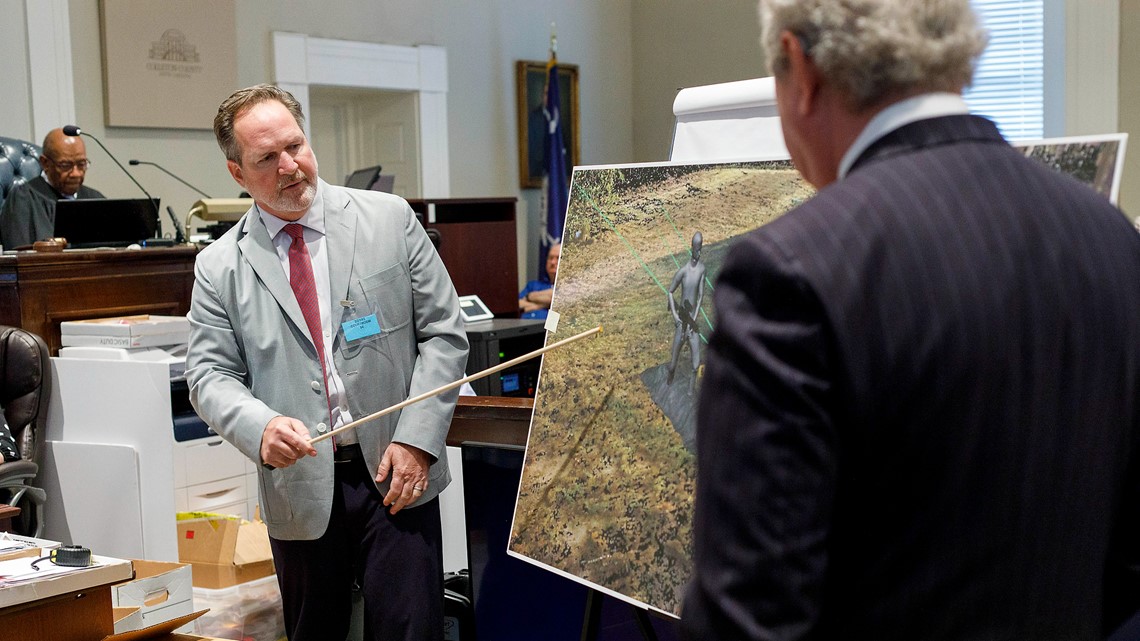
A PowerPoint presentation was presented by Sutton.
Shot trajectories in quail pen (small animal cage) near the barn, across from kennels. Bullet holes facing the crime scene were measured. And a bullet wipe (shows direction bullet came from) was found. In Sutton’s opinion, that bullet was in an upward trajectory, right to left, when it hit the quail pen and goes through the side of the hangar.
A photo of Worley’s measurement of the angle of the shot at the pen at Moselle is shown, Worley determined the bullet to be going up at 3 degrees, it was pretty flat, Sutton said. There is also a photo of the bullet at 1.5 degrees. Sutton noted the difference in the degrees. The bullet path of about 50 feet is unusual because of the upward trajectory, meaning the shooter had to be on that line for that shot. Worley determined that was a 300 Blackout shot.
Another image shows the 1.5-degree path, Worley got a range of degrees.
Another image shows the trajectory rod showing bullet passing through quail cage and back through the back of the pen.
Worley measured the azimuth at 40 degrees, showing the direction of the trajectory. In this case for this bullet, it is coming left to right.
The doghouse has bullet hole low to the ground, 3 inches from the bottom, Sutton said, and the bullet was going down and to the left. Sutton said that puts a limit on where the shooter could be. The trajectory rod shows the bullet traveling at 14 degrees down toward the ground. Worley measured 7 degrees, so the bullet was not straight on into the doghouse.
Worley’s not-to-scale diagram is presented. The not-to-scale diagram, Sutton says, has two shots – one each into the doghouse and quail pen. Drawing out the trajectory and seeing where the trajectories cross might give location of the shooter, Sutton said.
Sutton’s reconstruction of the 300 Blackout shooter is a video with overview of hangar with doghouse, and kennels across the way, and the quail pen. For a sense of perspective, he created a flyover view without the shed’s roof. Sutton presents a bird’s eye view of the scene with placement of Paul and Maggie’s bodies.
SLED had a FARO scan used for reconstruction and Sutton did view it. Sutton said the scans should be the same as only difference is SLED did theirs in July 2021 and Sutton did his in October 2022.
Sutton took Worley’s measurements and created a CAD diagram from the measurements. Once Sutton put the measurements of the evidence markers in his scan, he compared it to photos from the scene to verify positions. Sutton has video showing comparison of the night of murders and Sutton’s reconstruction.
Sutton picked a point in the reconstruction to show the trajectory of the bullet into the quail pen. A green line across the image, Sutton says, shows the trigonometry of the bullet at 1.5 and 3 degrees. The gun would be at any point on that line. To Sutton’s right of the image, there is a pile of ejected cases, as there should be using a 300 Blackout. Sutton created a shooter using a 300 Blackout and found it was improbable the shots were fired from the shoulder, probably low from the hip. Sutton’s diagram shows shooter along both the 1.5- and 3-degree lines. Sutton believes the shot into the quail cage was flatter than 3 degrees.
Sutton said the shooter was on the 1.5-degree line, gun on the hip.
Sutton’s diagram of two shots to Maggie shows the two shots trajectories and where the shooter probably stood -- and the location of the gun barrel along the trajectory. Using those measurements, Sutton concluded the shooter must have been 5‘ 2’’ to 5’4”. Sutton said he arrived at the height by scanning the height of different people for comparison. Alex stands 6’3” and measures 25 inches to his kneecap. The shooting hand for Alex would be at or below his kneecap. Alex’s position would not be a shooting position, according to Sutton, and it is unlikely a tall person made the shots into the doghouse and quail pen.
Sutton says shooter has to be around 5’-2” because the distance to the quail pen puts the shooter in an unusual shooting stance if he were taller. The area where Maggie’s body was found will put shooter in certain position and Sutton had to explain the angle, using the location of the ejected shell casings.
Sutton said in his opinion, Alex couldn’t have taken the shot.
Harpootlian asks Sutton if he ever saw SLED diagrams or tests comparing shooter heights? No.
Sutton's testimony continues after the lunch break.
Harpootlian moves to demonstrate the position of the possible shooter using the 300 Blackout in evidence. He asks Sutton to show him where the gun would be on his body. Ordinarily, the trigger hand would be low, around hip, but Sutton said the shots came from about 25 inches from the ground.
Based on the angles, Harpootlian asks, the shooter would be between 5’2” and 5’4” to make the angles and have the ejected shells piled where they were? Sutton said that is correct.
Moving on to Paul’s first shot, photos show a window on the south side of the wall with holes due to buckshot. Crime scene photos showed one of the buckshot pellets hit a pine tree behind the feed room.
Paul got shot in the chest and Sutton determined which hole in the window coincided with the pellet in the tree. Sutton said he strung a line between the tree and where Paul would have stood to get the angle of the shot. Sutton determined the height of the shot to be at 3’11”, in an upward trajectory. Sutton said he measures 5’10” and was able to take a stance comparable to the shooter.
Harpooltian said the second shot to Paul, the SLED agent said the shot came from 135 degrees from floor and went in at 45-degree angle to Paul’s shoulder. Sutton disagrees with the agent’s assessment.
Turning to acoustical testing—Sutton says he was asked to check if a person is in the main house, would they be able to hear gunshots at the kennel? Sutton took sound levels from similar suspect guns and factored in the distance and obstacles between the house and kennels. Sutton took his tests on January 2023 using a high-grade meter specialized to capture the sound of gunfire.
Sutton measured 1,142 feet between house and kennels and noted there is vegetation between the house and kennels. He took sound measurements inside the house for a baseline and set up equipment in the living room of the house. For test purposes, the shotgun was fired in and out of the feed room and the 300 Blackout was fired near the kennels.
Sutton’s results were the 12-gauge shotgun registered at 155 decibels (db), 300 Blackout at 165 db. He played an audio file of the 300 fired at the loudest direction to the house and recorded in the house and it is barely audible. Sutton said no one in the house would have heard the 300 Blackout shots.
Harpootlian asks Sutton if he recognizes graphs Sutton created showing the speed of Alex’s Suburban on the trip from Moselle to Almeda on June 7. Sutton has independently sourced the timeline from the SLED data. Sutton is asked, at 9:07 p.m., Alex is leaving Moselle? Yes
Harpootlian asks if Alex slows down at any point…where Maggie’s phone was found? Sutton says Alex was speeding up from mid 40s mph in that area.

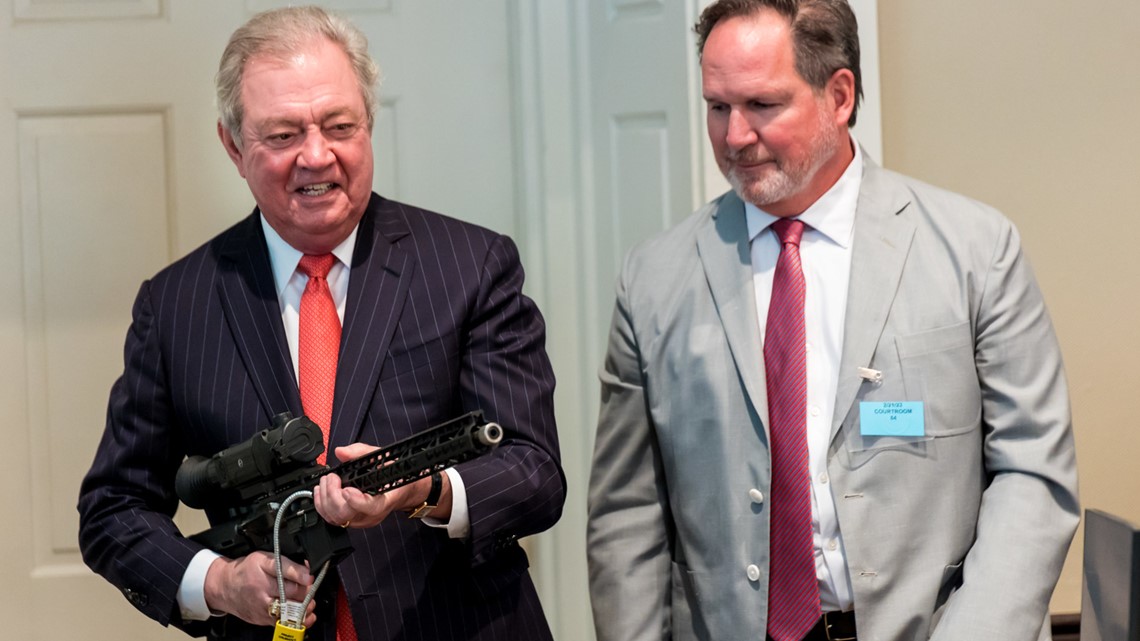
Sutton understands where Paul and Maggie’s bodies were found at the kennels. Harpootlian asks, would a driver be able to see the bodies in the headlights? Sutton answers, it depends on if the vehicle has high beam or low beam on, but the area in front of the Suburban would be well lit.
Based on the function of headlights on a motor vehicle and the path of the Suburban, the GPS data and photographs at the scene…would someone driving the vehicle be able to see the bodies? Yes. Objects may be 25 feet in front of the Suburban, the headlights would have illuminated the area.
Harpootlian asks, in your career of investigating motor vehicle accidents, have you analyzed the motion of items flying off vehicles in motion? Sutton says yes, it’s simple ballistics.
Harpootlian asks if an object the size of a phone separates from a vehicle traveling 45 mph, would it tumble? Depends on how it separated from the vehicle. Sutton said any object would tumble before coming to rest.
Speed data on the Suburban returning form Almeda to Moselle the State mentioned speed goes up to 80 mph before coming down. Sutton says the vehicle does reach high speeds for a bit, but it is not for any length of time, not a sustained speed.
CROSS EXAMINATION by David Fernandez
Fernandez asks Sutton if his practice focuses on accident reconstruction and civil litigation? Yes. Sutton was retained by Griffin in mid-September 2022.
Sutton was asked if he supplied any other report other than the Powerpoint and when was the Powerpoint completed? There is a summary report and the Powerpoint presentation was completed yesterday
One day before trial, is that standard? Yes
How much do you charge? $350 per hour, and Sutton estimates he has 40-50 hours in the case, plus travel. He does not work on retainers.
Ever worked for PMPED? No. Sutton has been on the other side of the case, never worked for the firm. Sutton did admit to working on the boat case. For Alex Murdaugh, after defense attorney Jim Griffin called him.
Engineering is a field based in science and math? Yes. Based in hard facts, would you agree? Yes.
Somethings, like guesswork, aren’t necessarily engineering problems? Sutton says when he is giving an opinion and that comes from the data.
If there are variables are not taken into consideration, is that guesswork? Sutton doesn’t engage in guesswork. Sutton says engineers cannot base opinions on assumptions.
Sutton has no formal training in firearms or pathology? No.
Fernandez asks if Sutton has taken any shooting reconstruction classes or classes relating to gunshot wounds to the body? No. Sutton once did test a bullet in a car door to try and determine the angle. He tests within the context of the case.
Fernandez asks if Sutton his tests are subject to peer review? No people in office may assist in tests, but Sutton generates his own reports.
Fernandez asks Sutton about the graph created from the OnStar data from the Suburban. He is asked to point out where on the chart the Suburban passed the location where Maggie’s phone was found.
Fernandez asks Sutton if there were specific times are on the chart? Sutton says not specifics. There are no times on the graphs along the x-axis.
Fernandez asks if Sutton if there are variables needed to be known in order to determine the path of an object thrown out of a window? How fast was car driving when phone thrown, condition of the road, speed it was thrown, direction the object was thrown (up, down, to front or back).
Mass not a factor? No. Wind resistance is. Depending on the question asked, you would need to the variables.
Sutton says photos presented to him resemble the side of the road he visited where Maggie’s phone was found. In the photos, the road gives way to a grassy area and a swath of vegetation.
Sound studies are primarily done for train whistles, backup alarms, sirens and emergency signals are Sutton’s primary work for civil litigation.
Fernandez asks about Sutton’s sound study at Moselle. The distance between house and kennels are approximately 1,150 feet. Griffin provided the shotgun and 300 Blackout for tests. Another engineer in Sutton’s firm did the shooting. The 12-gauge buckshot and birdshot ammunition were similar but not the same as the murder weapon’s ammunition.
The ambient noise level inside the house was 35 db. Sutton said ambient noise has an effect in how you hear something. A noise has to be 10 db above ambient for someone to hear something. The shot from the kennels at the house registered 3 db inside the house, very faint.
The trees made an affect on the sound level that Sutton said he compensated for – about 2 db.
The decibels of the shotgun was 150, the 300 was 165; Sutton is asked to extrapolate the sound of the gun to 1,250 feet. At 1024 feet, the 300 Blackout is 89.5 db outside the house. In a lab setting, it would be 105 db, the same as a jet flight at 1,000 feet.
Fernandez returns to the feed room with view of the window is a SLED image from June 7. Sutton is asked if he had looked through the window and lined up the hole in the window with the damaged trees. Yes
Fernandez is asked if he had any formal knowledge of shotguns? Sutton said he had. The spread is about the size of the window. The shotgun was probably three feet inside the room (according to Worley’s measurements) and the pellets spread through that point. Sutton would have to look up the range of fire for a shotgun and the choke. Sutton said he has not committed such information to memory.
Fernandez asks if Sutton is offering an opinion if he doesn’t know the spread of the pellets.
What are you basing the notion that all the pellets went through Paul’s body? Sutton said the ninth buckshot pellet went through the window frame. The window got shot and one of the pellets SLED didn’t recover was under the sill. There were eight holes in the window.


Sutton didn’t weigh the pellet he recovered from the window sill, he believes the pellet he recovered was from the crime scene.
Sutton testifies doesn’t have formal knowledge in firearm testing. He didn’t test shotguns for the case but says a pellet went through Paul and through the window and hit a tree. It doesn’t take a pathologist, he said, it’s simple math.
Alex is seen in a photo and his shoulder measures 64 inches above the floor.
Sutton said someone else operated the FARO equipment at Moselle and several engineers helped with this project.
The quail pen has a thin wood composite wall with a projectile hole. There is a margin of difference in measuring angles of entry. No projectile was recovered from this direction of shot.
The doghouse, at its highest point, measures 4 feet tall. The entry spot on the doghouse is near the bottom of the side of the doghouse and is wood. The bullet went through the wood and recovered inside the doghouse. Sutton hasn’t done testing of ballistics on wood, uses physics.
Fernandez asks about some of the FARO images: the position of Maggie’s body and bullet casings were added to the scan using SLED measurements. The green lines showing bullet trajectories of 1.5 and 3 degrees have a person standing 5’2” shooting from the hip, based on measurements.
Fernandez asks if bullets can ricochet? Sutton says its possible but not likely.
The shooter could be anywhere on the green line? Yes
Anyone on that line or any gun on that line could make the shot? Yes
Fernandez asks if Sutton has no rendering of adults kneeling while shooting? No. Sutton said he add one-foot increments from the quail pen and looked at height of shooter’s hand and location of spent casings and looked at 12-foot radius around the casings. Alex is 76 inches tall, if he went down on one knee, if he shouldered the gun, Sutton said it is his opinion Alex couldn’t make the shot. Whoever the shooter was, his hand was between 16.2-27.6 inches above the ground. In the model, the hand is 28 inches from the ground and 39 inches in a second model.
Sutton calculated the muzzle of the gun to be 29 inches above the ground where the doghouse was hit.
Fernandez demonstrates the possible heights of the muzzle within 5 feet of Sutton’s report to show a taller person could have made the shots.
The ejection from the rifle is supposed to be to the right. Fernandez asks if cartridge casings were removed or ejected in an abnormal fashion or ejected and ricocheted? Yes. Sutton said you’re looking at a spot within the 24 feet of shell casings.
Is it possible shooter shoots one shot and moves and shoots again? Yes.
Is it possible the shooter moved and changed his posture? Its possible. Sutton heard the shooter was moving. He said the physical evidence are what Worley and he gathered and drew a conclusion from the evidence. Sutton stands by his opinion of the height of the shooter.
Sutton’s calculations take into account trajectories passing though wood or a human body.
Where the gun was held, it was not a variable in the shot trajectories? How the gun was held? If the body was walking or in motion? No. Sutton says that is not what he looks into, not what he determines.
Is it a variable if the person shot is moving of if the shooter is moving? Not a variable.
REDIRECT
Harpootlian asks Sutton about variables – a hypothetical – a bullet 10 foot up a bullet 5 foot up? Sutton responds, a bullet descending
Sutton says where the shooter was in relation to the weapon, but he isn’t testifying about those matters.
The data relied on was generated by SLED. Any evidenced of ricochet or passing through a person? No
So, you’re saying this is the line based on SLED Agent Worley figuring about the angles.
Sutton says his reports are based on Worley’s data.
Sutton is shown a SLED report of Worley’s observations at the scene. He is asked to read out the five bullet defects in the feed room window that were buckshot. Two defects were found in the window (count is up to 7 out of 9). Two defects in doghouse were from the 300 Blackout. Sutton said Worley’s measurement was off a degree, maybe, but he was looking at a photograph of her instruments. Sutton did not read of ricochet or biological matter recorded by THEIR agents (emphasis by Harpootlian).
Seven buckshot pellets went through the window and Sutton measured through the upper leftmost hole in the window to make his measurements. Sutton relied on SLED data and physical measurements he took in October 2022.
Sutton was at Moselle within 90 days of Alex’s arrest for murder. Harpootlian said it took SLED a year to arrest Alex.
Sutton said shotgun was not loud enough to be heard at the house. The Blackout may be heard inside the house, but it would depend on variables. If you were outside and a couple of miles away, you could hear the shots, Sutton says, but not if you were inside the house.
Harpootlian asks if Sutton found any data or evidence that SLED did the same trajectory mapping he did? No
What FARO did SLED do? Sutton knows they scanned the scene in July but hasn’t seen anything since that.
What trajectory computations were done, Harpootlian asks, did you see any? Sutton has seen none.
Anything to prevent SLED to do same calculations Sutton did? None
Based on Sutton’s calculations and assumption someone holding rifle at the hip or shoulder in a way to operate the weapon, what opinion is it that Alex was the one shooting into the quail pen? Sutton says it can’t be Alex.
RE-CROSS
The weapon is on the green line, anyone on that line could be the shooter? yes
If at the kennels, you would have heard it? yes
The trial resumes at 9:30 a.m. on Wednesday.
You can find trial updates here every day. Watch live streaming testimony and coverage can be on wltx.com, on the WLTX+ streaming app on Amazon Fire and Roku TV, and on the News19 WLTX YouTube page.

